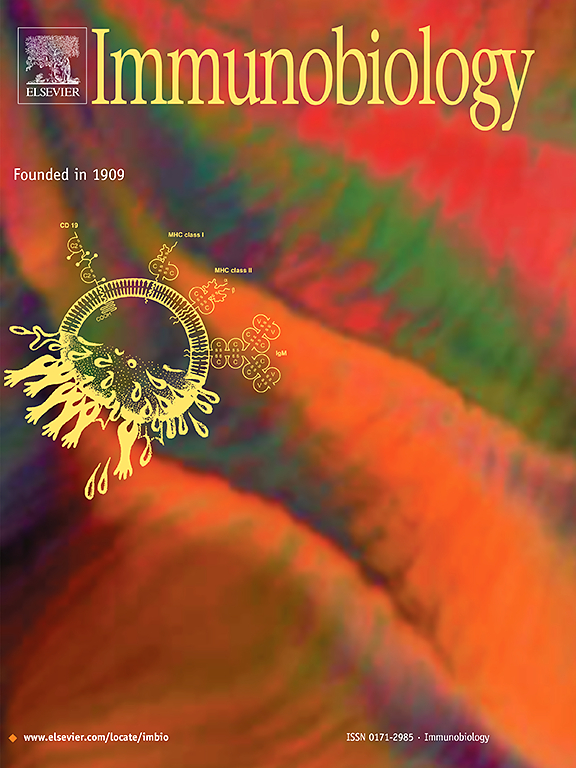Integrated analyses uncover new features of atypical memory B cells and novel targets for intervention
IF 2.3
4区 医学
Q3 IMMUNOLOGY
引用次数: 0
Abstract
Background
Atypical memory B (AMB) is a novel subset of B lymphocytes, but its immune features and pathogenetic roles in systemic rheumatic diseases are still largely elusive. This study aimed to characterize transcriptomic features, immune phenotypes and potential signaling pathways of AMB, and also to confirm its alternations in systemic rheumatic diseases via combined transcriptome analyses.
Method
B cell subsets and their transcriptomic signatures were identified via analyses of single cell RNA-sequencing (scRNA-seq) data. Functional characterization of AMB was performed with bioinformatics and CyTOF-based phenotyping. Alternation of AMB in systemic lupus erythematosus (SLE), rheumatoid arthritis (RA) and Sjögren's syndrome (SjS) was evaluated via bioinformatic approaches.
Result
A total of 11 B cell subsets including AMB were identified through scRNA-seq transcriptome analyses. Both transcriptome analyses and CyTOF-based immune phenotyping confirmed that AMB had increased levels of TBX21 (T-bet), ITGAX (CD11c), CD19, CD20 and CXCR3 (P < 0.05), and it had decreased expressions of CD27, CD38, CXCR4, CXCR5 and CD62L (P < 0.05). More than 50 % of T-bet+ B cells did not express CD11c, and more than 30 % expressed CD27. AMB was characterized by activated mTORC1 signaling and increased p-P38 level (P < 0.05). AMB transcriptional signature was significantly enriched in the peripheral blood and disease tissues of patients of SLE, RA and SjS (P < 0.05), suggesting the expanded AMB cells in those patients.
Conclusion
This study defines the transcriptomic signature, immune phenotypes and potential signaling pathways of AMB, and also confirms the involvement of AMB in systemic rheumatic diseases including SLE, RA and SjS via transcriptomic approaches. mTORC1 signaling and P38/MAPK signaling are promising therapeutic targets for systemic rheumatic diseases mediated by AMB.
综合分析揭示了非典型记忆B细胞的新特征和新的干预靶点
典型记忆B (AMB)是B淋巴细胞的一个新亚群,但其免疫特性和在系统性风湿病中的发病作用仍在很大程度上难以捉摸。本研究旨在表征AMB的转录组特征、免疫表型和潜在的信号通路,并通过联合转录组分析证实其在系统性风湿性疾病中的改变。方法通过单细胞rna测序(scRNA-seq)数据分析,鉴定db细胞亚群及其转录组特征。利用生物信息学和基于细胞f的表型分析对AMB进行功能表征。通过生物信息学方法评估系统性红斑狼疮(SLE)、类风湿性关节炎(RA)和Sjögren综合征(SjS)患者AMB的变化。结果通过scRNA-seq转录组分析,共鉴定出包括AMB在内的11个B细胞亚群。转录组分析和基于细胞f的免疫表型分析证实,AMB的TBX21 (T-bet)、ITGAX (CD11c)、CD19、CD20和CXCR3 (P <;0.05), CD27、CD38、CXCR4、CXCR5和CD62L的表达均降低(P <;0.05)。超过50%的T-bet+ B细胞不表达CD11c,超过30%表达CD27。AMB的特征是mTORC1信号被激活,P - p38水平升高(P <;0.05)。SLE、RA和SjS患者外周血和疾病组织中AMB转录特征显著富集(P <;0.05),提示患者AMB细胞扩增。结论本研究明确了AMB的转录组特征、免疫表型和潜在的信号通路,并通过转录组学方法证实了AMB参与系统性风湿病,包括SLE、RA和SjS。mTORC1信号和P38/MAPK信号是AMB介导的系统性风湿病的有希望的治疗靶点。
本文章由计算机程序翻译,如有差异,请以英文原文为准。
求助全文
约1分钟内获得全文
求助全文
来源期刊

Immunobiology
医学-免疫学
CiteScore
5.00
自引率
3.60%
发文量
108
审稿时长
55 days
期刊介绍:
Immunobiology is a peer-reviewed journal that publishes highly innovative research approaches for a wide range of immunological subjects, including
• Innate Immunity,
• Adaptive Immunity,
• Complement Biology,
• Macrophage and Dendritic Cell Biology,
• Parasite Immunology,
• Tumour Immunology,
• Clinical Immunology,
• Immunogenetics,
• Immunotherapy and
• Immunopathology of infectious, allergic and autoimmune disease.
 求助内容:
求助内容: 应助结果提醒方式:
应助结果提醒方式:


